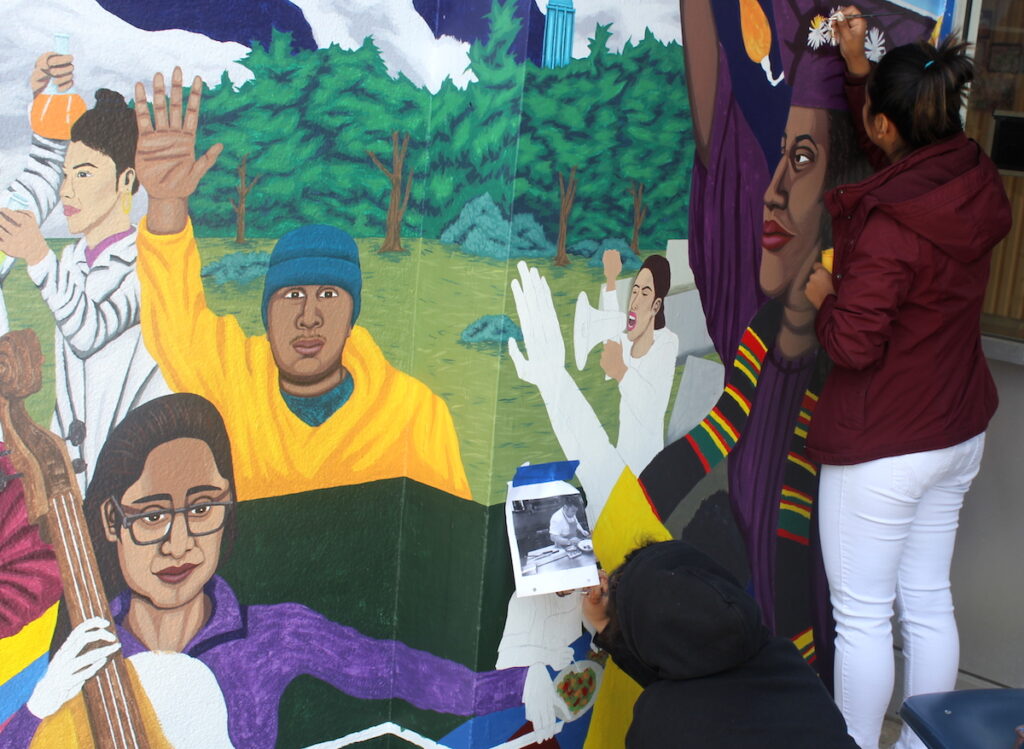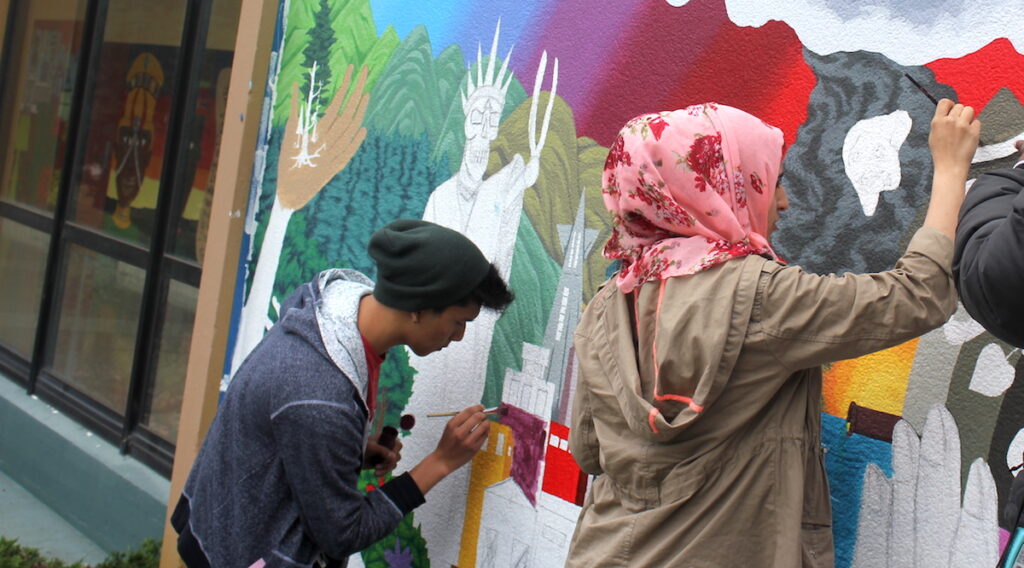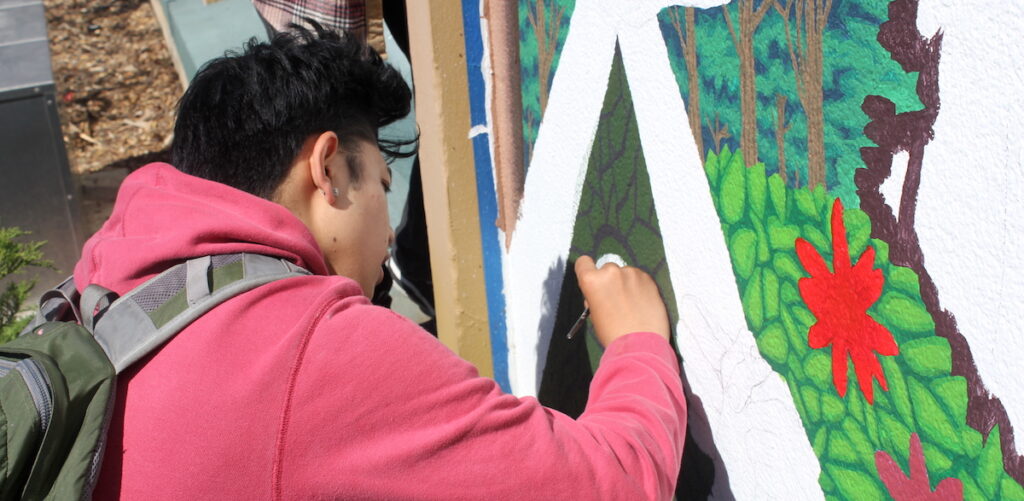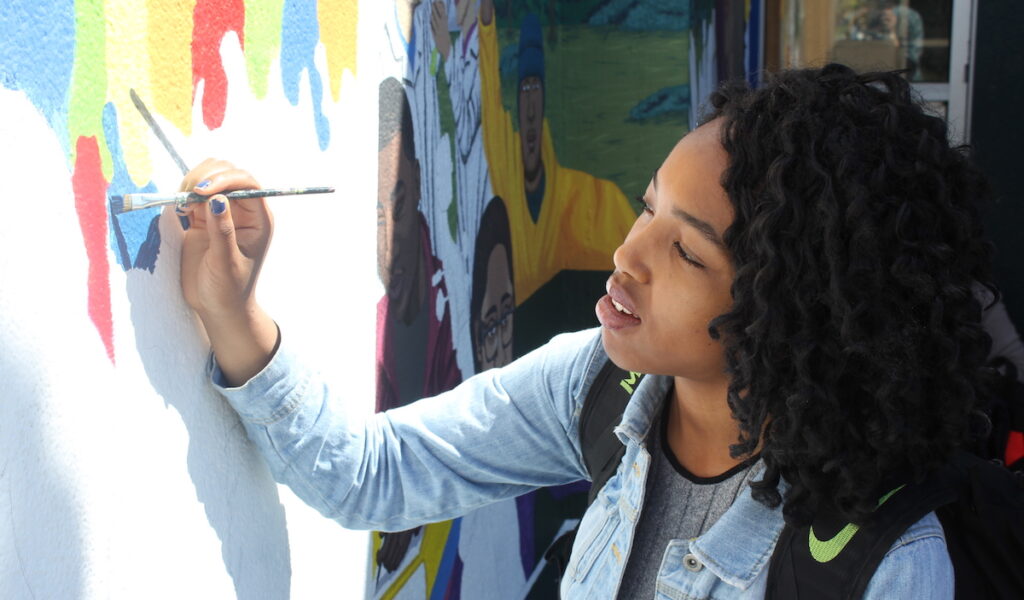Have you ever wanted to lead a mural project with students? Now is the time! Creating a mural is one of the most profound and rewarding projects in the realm of art education. While murals have the power to transform art programs and school communities, they are often viewed with skepticism and doubt. Administrators might be reluctant to have students create such a long-lasting art piece on the school. Educators might hesitate or feel anxious about the rigor, uncertainty, and accountability associated with the finished piece.
Regardless of the rationale behind the resistance, there are many compelling reasons to run a mural project with your students.

Murals Support a Natural Progression of Skills
Visual arts curriculum often builds from studies in drawing to color theory to painting and concludes with sculpture. There are countless deviations that disrupt this pattern, but ultimately line leads to shape, shape leads to form, and color comes up along the way. Therefore, the progression of a visual arts course can naturally culminate with a mural. A mural can be designed through a class or a club. Students studying drawing and painting need to have an opportunity to challenge their skills and creative talents in a more powerful, public format.
Murals Act as an Art Advocacy Tool
Murals are not a passive form of art. Murals are primarily made for public interaction and communication. To have murals on your school walls is to send the message that the arts are important. It’s sad but all too common that people see cuts to art program budgets as logical and necessary. Who else is going to stand up for the arts if not art educators? Having a display of some incredible, dynamic, student-generated murals to invigorate the space of the school is a key form of arts advocacy.

Murals Empower Students
Students creating a mural for their school are actively changing the space. They are engaged in an opportunity to communicate with their peers about issues, topics, and imagery important to them. The mural is not hidden on a shelf or stashed away in a folder. It is on display at any time of any day for anyone to see. There is no more authentic, relevant project in art education for students to create together than a mural. The large scale and validation of student abilities murals provide can spark a new vision and purpose in individuals who participate in making them. While plays, films, and musical performances are also extremely high on the art education empowerment scale, a mural speaks to viewers at every hour of every day, maximizing audience potential.
Murals Enrich the Community
Murals are the ideal medium to encourage collaboration between every age, gender identity, race, and religious affiliation. Murals can incorporate the ideas, sketches, values, and artistic contributions of students, staff, and neighborhood members throughout the various stages of the process. A mural can communicate what a school community values, appreciates, or wants to see for the future. Not only does the final product beautify and uplift the space, it gives a sense of ownership back to the students and stakeholders. A school willing to give students the chance to decorate their academic space with their own collaborative artistic rigor is a school nourishing positive community culture.

Murals are a Form of Communication
Art projects come and go. Murals are here to stay. They are a legacy, a means for students, staff, and stakeholders to communicate from generation to generation. Murals are an artistic dialogue serving to provoke and inspire present and future student populations. Murals speak to school bodies. Students not only enjoy the visual power and beauty that charges their school walls, but they analyze the symbolism and message being promoted by their peers. Students can challenge, educate, motivate, and engage other students in other times through the creation of murals.
Murals Demand Rigor
Academic rigor is work that is thorough, demanding, and difficult. Educators value the concept of rigor because it implies students must overcome significant struggle and persist to achieve an intended outcome. Rigor is necessary for most things that have true value and significance, so rigor is a quality that applies directly to creating positive changes in life. Murals, like theatrical performances, require an extraordinary amount of time, practice, dedication, and revision. Murals require team effort and sacrifices. Murals can make students feel pain from muscles they have not used before, or ask students to put in hours of work after school they would rather not do. Murals demand excellence of technique and raise the stakes for what students consider to be a finished rendering in the imagery of the composition. The amount of rigor murals involve is at the top of the charts.

You may still feel unsure or unsupported, but don’t let that stop you!
In the case of those who do not have administrative support for a mural project, try advocating for a portable piece. Murals do not have to be painted directly onto school walls. Wood, plastic, or Tyvek panels can make wonderful surfaces and can be removed for any reason. Anxiety or doubt around our own abilities to lead a mural project can be quelled with practice. Start a small project on a less-permanent surface, such as butcher paper or cardboard. Training to do a mural with a small group of students is a smart and often essential step to identify areas of growth needed before taking on a larger task. If you have ever had the urge to try a mural painting project with your students, now is the time.
The challenges for art educators to implement murals come in various forms. Administration might not be as excited to take the mural risk. Art educators might not feel confident enough to lead the project. The accountability after the finished mural is up for all to see for an unknown time to come can be daunting. None of these reasons outweigh the positive, powerful potential a community mural can provide a school community. Providing your students experience in a mural-based art education is something you and your students will never forget.
What is keeping you from implementing a mural project with your students?
What advice can you offer others who are interested in leading a mural project?
Magazine articles and podcasts are opinions of professional education contributors and do not necessarily represent the position of the Art of Education University (AOEU) or its academic offerings. Contributors use terms in the way they are most often talked about in the scope of their educational experiences.





